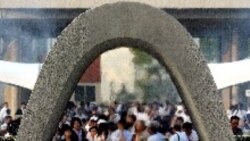That's why she was in her mother's arms and not crawling on the floor as usual, when at 8:15 exactly, the Enola Gay dropped its atomic bomb just 1.5 kilometers away.
It meant Tanimoto-Kondo and her mother were together when their house collapsed, trapping them in the rubble until Kondo's crying stirred her mother back to consciousness.
"At first she thought, 'Ah, a baby is crying somewhere.' And then suddenly the crying cut off completely and then [with] her mother's instinct she realized that it was her baby, that's me, [and that I] could not cry any more because I could not breathe any more," Tanimoto-Kondo recalls. "So my mother realized and at first she asked for help but no one came. She moved little by little and finally she was able to make a little hole [above] her head and she took me out of the house. When she was out she saw fires all over the place."
Tanimoto-Kondo was uninjured. But her early memories are of the many people who were disfigured by terrible burns -- including young women who came to be known as the "Hiroshima Maidens."
"Some of them, their eyes could not close, or the mouth could not close because the lips were together with the chin," Tanimoto-Kondo says. "As a child I didn't know where to look. I thought about it, why these girls are so ugly-looking? And I learned and found out they were other survivors of Hiroshima. They were burnt by the fire. And I said to myself when I grow up I am really going to give a big punch to whoever was on the B-29 Enola Gay, to [take] revenge."
Then in 1955 Tanimoto-Kondo had an encounter that would have a lasting effect.
Her father had arranged to escort 25 of the disfigured young women to the United States for plastic surgery.
While there, he was invited on a popular television show, "This Is Your Life," that would reunite him with people who had played an important role in his life.
Tanimoto-Kondo went along. "I could recognize many of the people who were on the show except one man," she says. "I was only 10 and was so curious. I asked my mother, 'Who is that man over there?' She told me, 'The man over there, his name is Captain Robert Lewis, he was a co-pilot of the Enola Gay.'"
As such, Lewis had been part of a mission considered by many to be crucial in ending the war.
The United States said dropping the bomb was the only way to force a Japanese surrender and avoid what was expected to be a long and bloody U.S. invasion.
Some historians dispute that, arguing that more could have been done to negotiate an end to the war -- and that the prospect of a Soviet invasion was a bigger factor in Japan's decision to surrender.
That day in the television studio, Tanimoto-Kondo watched as Lewis described how it felt to have dropped the bomb.
"Captain Lewis said [that] from the airplane he saw the city of Hiroshima [had] disappeared and he said, 'My God, what have we done?' I thought he was the enemy, that man," Tanimoto-Kondo says. "But after he said the words 'My God, what have we done?' I looked at his eyes and saw his tears come out and I felt so sorry, and I prayed to God: 'I'm sorry, please forgive me, God, I hated this guy, but if I hate I should hate war itself, not this guy and please forgive me.'"
These days Tanimoto-Kondo is one of the most prominent of the Hiroshima survivors, known as the "Hibakusha," and frequently travels abroad to talk about her experiences and the need for reconciliation.
She's also met a survivor of Japan's bombing of Pearl Harbor in the United States.
On the day she speaks to RFE/RL she's just finished talking to a group of American college students at Hiroshima's museum. All she can do, she says, is to lead people like them to "walk toward peace."





